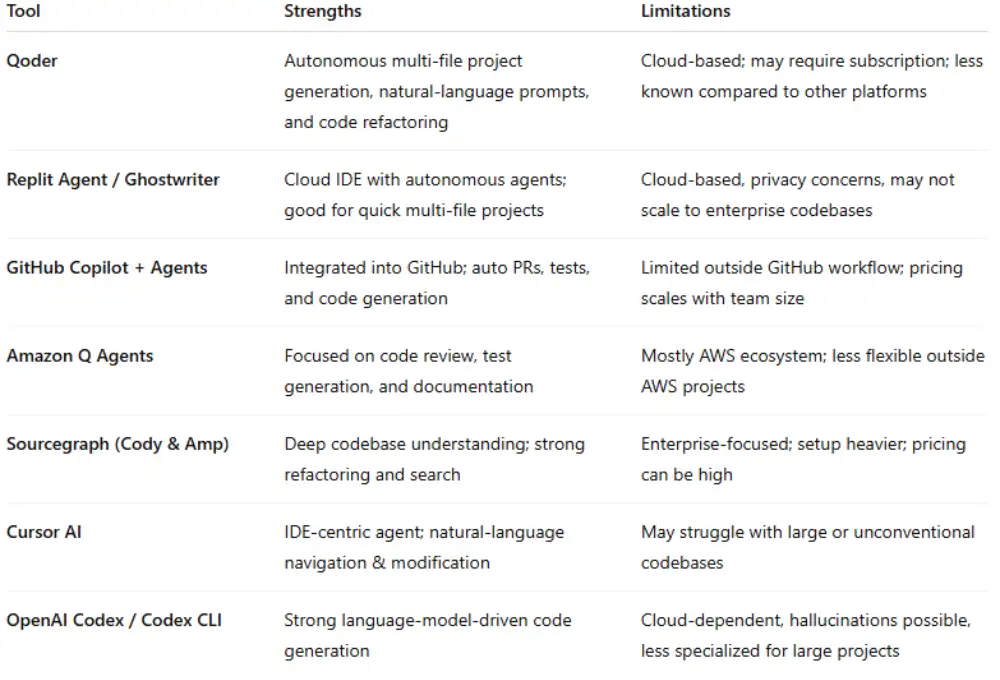The rise of autonomous coding agents marks a turning point in software engineering. In 2025, AI has evolved from simple code completion assistants into self-directed systems capable of analyzing repositories, planning tasks, debugging, refactoring, and even deploying applications—all with minimal human oversight.
But what exactly are autonomous coding agents? How do they differ from traditional AI assistants like GitHub Copilot or ChatGPT? And how do concepts from AI agent architectures—reflex, model-based, goal-based, utility-based, and learning agents—apply to real-world software engineering?
This article explores the evolution, architecture, and applications of autonomous coding agents through the lens of AI agent theory, supported by real examples, workflows, and expert insights.

Understanding Autonomous Coding Agents
Autonomous coding agents are AI-driven systems that can independently perform end-to-end programming tasks—from understanding requirements and writing code to testing and deployment. They integrate LLMs (Large Language Models) with tool use, memory, and environmental awareness, allowing them to act as decision-making entities within the software development lifecycle.
In simple terms, an autonomous coding agent doesn’t just complete your code—it understands the goal, plans the steps, and executes them.
Key Characteristics
- Autonomy: Executes coding tasks without manual prompts.
- Goal-oriented behavior: Works toward objectives like “build an API” or “fix this bug.”
- Learning and feedback: Improves performance based on previous errors or user corrections.
- Environmental awareness: Understands repository structure, documentation, and dependencies.
These features align closely with the five types of AI agents in modern AI theory.
Applying the 5 Types of AI Agents to Coding Automation
Simple Reflex Agents → Static Code Tools
A simple reflex agent follows predefined “if–then” rules. In coding, this is akin to static analyzers or linters like ESLint or Pylint.
- Behavior: “If code violates rule X, then flag error Y.”
- Example:
if line_length > 80:
print(“Warning: Line too long”)
- Limitation: No learning or contextual understanding. Works best for deterministic rules.
Reflex-like behavior is foundational but limited. True autonomy requires contextual reasoning—which is where model-based agents emerge.
Model-Based Reflex Agents → Context-Aware Code Editors
Model-based agents track the state of the environment. In development, that means understanding your project context—file relationships, import hierarchies, dependencies.
A model-based coding agent can:
- Infer where a function is defined.
- Predict what a module does based on usage.
- Track previous edits to avoid conflicts.
Example use case:
GitHub Copilot X or Cursor AI Editor maintaining awareness of your repo state to give context-specific suggestions.
“It remembers where it’s been and what areas are clean,” just like the robotic vacuum analogy—only here, the “room” is your codebase.
Goal-Based Agents → Task-Oriented Coders
Goal-based agents plan actions based on desired outcomes.
An autonomous coding agent of this type might be told:
“Build a REST API for a blog platform.”
It will:
- Analyze existing code and dependencies.
- Plan subtasks: models → routes → controllers → tests.
- Execute code generation and validation.
Example pseudocode (goal-directed reasoning):
goal = “Build blog API”
plan = agent.plan(goal)
for step in plan:
agent.execute(step)
The goal drives decisions—just like self-driving cars calculate optimal routes. This makes them ideal for full-stack automation and DevOps integration.
Utility-Based Agents → Optimized Coders
Utility-based agents evaluate multiple outcomes and choose the one with the highest value (or lowest risk).
For coding agents, utility could mean:
- Fewer bugs
- Higher performance
- Faster execution
- Minimal technical debt
Example:
A refactoring agent choosing between two methods—one shorter, one faster.
def compute_utility(code_variant):
score = test_pass_rate * 0.6 + perf_score * 0.4
return score
best_code = max(code_variants, key=compute_utility)
This behavior moves beyond automation—it’s optimization. Utility-driven coding agents enable sustainable code evolution, balancing speed with quality.
Learning Agents → Self-Improving Coders
Learning agents are the most advanced. They learn from feedback, adapt over time, and generalize from new experiences.
In coding, that means:
- Learning from pull request reviews.
- Adapting to your preferred architecture or naming conventions.
- Reducing repetition and improving prediction accuracy over time.
Example: A learning agent detects your team’s preference for functional patterns over OOP and gradually shifts its code suggestions accordingly.
These agents have a “critic” (reviews output), a “learning element” (updates strategy), and a “problem generator” (explores new approaches)—exactly as defined in agentic AI theory.

Architecture of an Autonomous Coding Agent
A modern autonomous coding agent combines multiple layers of intelligence:
- Perception Layer: Reads environment (repository, files, APIs).
- Reasoning Layer: Uses LLMs to infer goals and plan actions.
- Action Layer: Executes actions through tools or APIs (e.g., Git, Docker).
- Feedback Layer: Observes results, applies reinforcement learning.
Code-like structure:
class CodingAgent:
def perceive(self, repo):
self.state = analyze_repo(repo)
def decide(self):
self.plan = generate_plan(self.state)
def act(self):
for task in self.plan:
execute(task)
def learn(self, feedback):
update_model(feedback)
Real-World Applications
Autonomous Code Review
AI agents like CodeRabbit and Sweep automate pull request reviews, detecting logic errors, code smells, and dependency issues autonomously.
Continuous Integration (CI/CD) Automation
Agents integrated with Jenkins or GitHub Actions can trigger, monitor, and fix build failures autonomously.
Autonomous Bug Fixing
Tools like SWE-Agent and AutoGPT-Code can identify and fix bugs in open-source projects, often surpassing human performance in repetitive debugging.
Full-Stack Development
Goal-based agents like Devin (by Cognition AI) and OpenDevin execute coding, testing, and deployment steps independently, following a human-assigned task list.
Adaptive Learning Systems
Learning agents within IDEs adapt to individual developer patterns—reducing friction and improving code quality across iterations.

Challenges & Ethical Considerations
While powerful, autonomous coding agents raise critical questions:
- Accountability: Who’s responsible for AI-generated code errors?
- Security: Can malicious code be introduced unintentionally?
- Transparency: Should AI disclose which code segments were self-written?
- Job Impact: Will developers shift from creators to curators of AI-generated logic?
Addressing these requires a balanced human-in-the-loop model—leveraging automation while maintaining ethical oversight.
Future Outlook
As agents evolve, multi-agent systems (MAS) will enable collaborative AI environments where specialized agents handle tasks like design, testing, documentation, and deployment in parallel.
The future of coding isn’t a single AI replacing humans—it’s a network of agents augmenting every layer of the development stack.
Emerging research suggests that hybrid learning agents, combining reinforcement learning with symbolic reasoning, may soon handle open-ended software challenges.
Conclusion
Autonomous coding agents represent a leap forward—from passive assistants to active collaborators in the software creation process.
By applying the logic of AI agent theory—reflexes, modeling, goals, utility, and learning—developers and organizations can better understand, deploy, and trust these powerful tools.
The future of coding is autonomous, intelligent, and deeply human-guided.
